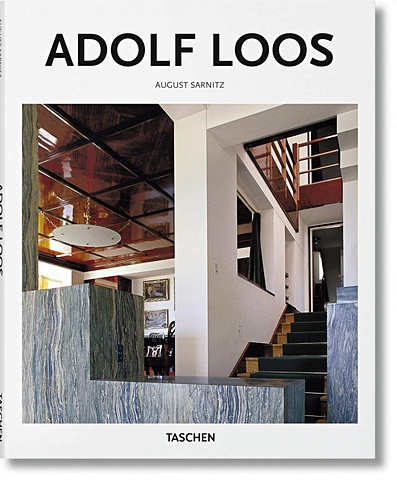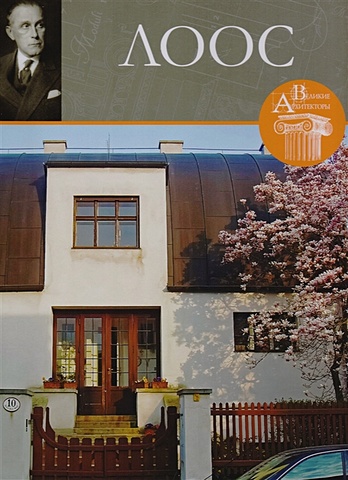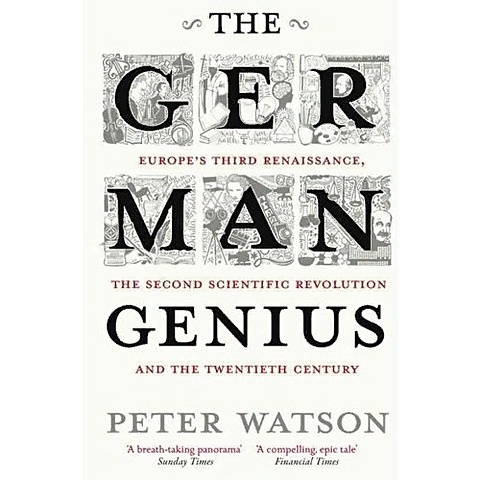сарниц а adolf loos 1870 1933 architect cultural critic dandy

Сарниц А. Adolf Loos: 1870-1933: Architect, Cultural Critic, Dandy
Adolf Loos (1870–1933) was a flamboyant character whose presence in the cultural hotbed of early 1900s Vienna galvanized the country’s architectural landscape. An early, impassioned advocate of modernism, he all-out rejected the grand Secessionist aesthetic prevalent at the time, as well as any hallmarks of the European fin de siecle.Instead, in lectures and essays, such as the milestone Ornament and Crime of 1908, Loos articulated his “passion for smooth and precious surfaces.” He advocated that architectural ornamentation was, by its nature, ephemeral—locked into current trends and styles, and therefore quickly dated. Loos, himself a Classicist at heart, argued instead for simple, timeless designs with time-honored aesthetic and structural qualities.In this essential introduction, we explore Loos’s writings, projects, and legacy, from his key concept of “spatial plan” architecture to his rejection of decorative fripperies in favor of opulent, fine-quality materials and crisp lines. Featured projects include Vienna’s Cafe Museum (1899), the fashion store Knize (1913), and the controversial Loos House (1912), which Emperor Franz Joseph I would refuse to travel past, bristling with rage at its insolently minimalist aesthetic.
2007 Руб.
НАЙТИ ЕЩЕ
Сарниц А. Adolf Loos: 1870-1933: Architect, Cultural Critic, Dandy
Adolf Loos (1870–1933) was a flamboyant character whose presence in the cultural hotbed of early 1900s Vienna galvanized the country’s architectural landscape. An early, impassioned advocate of modernism, he all-out rejected the grand Secessionist aesthetic prevalent at the time, as well as any hallmarks of the European fin de siecle.Instead, in lectures and essays, such as the milestone Ornament and Crime of 1908, Loos articulated his “passion for smooth and precious surfaces.” He advocated that architectural ornamentation was, by its nature, ephemeral—locked into current trends and styles, and therefore quickly dated. Loos, himself a Classicist at heart, argued instead for simple, timeless designs with time-honored aesthetic and structural qualities.In this essential introduction, we explore Loos’s writings, projects, and legacy, from his key concept of “spatial plan” architecture to his rejection of decorative fripperies in favor of opulent, fine-quality materials and crisp lines. Featured projects include Vienna’s Cafe Museum (1899), the fashion store Knize (1913), and the controversial Loos House (1912), which Emperor Franz Joseph I would refuse to travel past, bristling with rage at its insolently minimalist aesthetic.
2007 Руб.
НАЙТИ ЕЩЕ
Sarnitz August Adolf Loos
Adolf Loos – Avantgardist und Storenfried im Wien der Secessionisten Erst legte er sich mit den biedersinnigen Freunden des Historismus und der Wiener Ringstra?en-Architektur an, dann mit den Secessionisten, mit denen er gerade noch paktiert hatte: Nike Wagner zitiert in „Geist und Geschlecht“, ihrem Standardwerk zu Karl Kraus und der Wiener Moderne, einen Zeitgenossen von Adolf Loos (1870–1933), der den Architekten, Designer und Publizisten als den „Mann, der Nein sagt“ charakterisierte. Und kaum jemand sagte mit mehr avantgardistischem Furor Nein als Loos: Nein zum Ornament, zum dekorativen Beiwerk, zu uberflussigen Details, zum fantastischen Wuchern des Irrationalen. Als Architekt der Tabula rasa propagierte Loos eine Architektur der Einfachheit und Klarheit, in der die Form der Funktion folgt, aber durchaus luxuriosen Uberfluss und das Spiel mit klassizistischen Elementen zulasst. Programmatisch ist sein Vortrag Ornament und Verbrechen (1913), in dem er in nietzscheanischer Erregungs- und Uberwaltigungsprosa gegen den antiquierten Unverstand seiner Zeitgenossen wettert. Schon zu Beginn des 20. Jahrhunderts hatte der Freund von Karl Kraus, Peter Altenberg und Oskar Kokoschka die Gelegenheit erhalten, seine Ideen auch baulich Gestalt werden zu lassen. Die schlicht-funktionalen Innenraumgestaltungen, die er fur das Cafe Museum (1899), fur die American Bar (1908) oder das Modehaus Knize (1913) entwarf, bruskierten in ihrer fremdartigen modernen Anmutung die Wiener. Auch sein wohl beruhmtestes Bauwerk in Wien, das als Looshaus bekannte gro?e Geschaftshaus am Michaelerplatz (1912) gegenuber der Nordfassade der Hofburg, wurde mit seiner nuchternen, aber dennoch exklusiv-eleganten Fassade als Provokation empfunden und soll sogar Kaiser Franz Joseph I. derart in Rage versetzt haben, dass er sich fortan weigerte, einen Fu? auf den Michaelerplatz zu setzen. Das Looshaus wie auch einige der zahlreichen Villen, die er baute, etwa die kubistische Villa Muller in Prag, gelten als Schlusselwerke der Moderne. Diese Einfuhrung macht mit den architektonischen Ideen von Adolf Loos vertraut, erlautert sein Konzept des „Raumplans“, stellt seine wichtigsten Werke vor und beschreibt das Leben eines streitbaren, aber auch abgrundigen Intellektuellen am Beginn der Moderne.
3435 Руб.
НАЙТИ ЕЩЕ
Loos Adolf Ornament and Crime
Revolutionary essays on design, aesthetics and materialism - from one of the great masters of modern architecture Adolf Loos, the great Viennese pioneer of modern architecture, was a hater of the fake, the fussy and the lavishly decorated, and a lover of stripped down, clean simplicity. He was also a writer of effervescent, caustic wit, as shown in this selection of essays on all aspects of design and aesthetics, from cities to glassware, furniture to footwear, architectural training to why 'the lack of ornament is a sign of intellectual power'.
2607 Руб.
НАЙТИ ЕЩЕ
Зимина Л. Адольф Лоос (1870-1933)
Гениальный зодчий и дизайнер Адольф Лоос — уникальное явление европейской культуры начала XX века. Его проекты и постройки — блестящее архитектурное наследие Австрии и Чехии, а теоретические работы и публицистика — памятники эстетической мысли. Лоос — автор эпатажного манифеста «Орнамент и преступление» и скандально знаменитого «дома без бровей» на Михаэлерилаи в сердце Вены. Кафе «Музеум» и Лоос-Бар — любимые места отдыха гостей и жителей австрийской столицы. Вилла Мюллера — один из самых посещаемых национальных музеев Чехии. «Стиль Лооса» до сих пор акту ален в дизайне мебели и светильников, носящих имя их создателя. Неподражаемое творчество Лооса сплошь пронизано парадоксами. Шагнув из эпохи модерна в эпоху модернизма, он неизменно остается приверженцем собственного художественного стиля, синтезируя в нем авангардное и архаичное, рациональное и роскошное, функциональное и традиционное. В изысканных интерьерах Лооса проступают и черты ар-деко, позволяя причислить его к пионерам этого направления в искусстве.
81 Руб.
НАЙТИ ЕЩЕ
Зимина Л. Адольф Лоос (1870-1933)
Гениальный зодчий и дизайнер Адольф Лоос — уникальное явление европейской культуры начала XX века. Его проекты и постройки — блестящее архитектурное наследие Австрии и Чехии, а теоретические работы и публицистика — памятники эстетической мысли. Лоос — автор эпатажного манифеста «Орнамент и преступление» и скандально знаменитого «дома без бровей» на Михаэлерилаи в сердце Вены. Кафе «Музеум» и Лоос-Бар — любимые места отдыха гостей и жителей австрийской столицы. Вилла Мюллера — один из самых посещаемых национальных музеев Чехии. «Стиль Лооса» до сих пор акту ален в дизайне мебели и светильников, носящих имя их создателя. Неподражаемое творчество Лооса сплошь пронизано парадоксами. Шагнув из эпохи модерна в эпоху модернизма, он неизменно остается приверженцем собственного художественного стиля, синтезируя в нем авангардное и архаичное, рациональное и роскошное, функциональное и традиционное. В изысканных интерьерах Лооса проступают и черты ар-деко, позволяя причислить его к пионерам этого направления в искусстве.
81 Руб.
НАЙТИ ЕЩЕ
Минцлов Сергей Рудольфович Чернокнижник
Сергей Рудольфович Минцлов (1870—1933) — русский писатель, автор ряда исторических романов, ценитель и знаток русской книги, библиограф, участник нескольких археологических экспедиций. Книги Минцлова пользовались огромной популярностью у русских эмигрантов. В 1933 году его книги занимали первое место по выдачам в Тургеневской библиотеке в Париже.
1035 Руб.
НАЙТИ ЕЩЕ
Watson P. German Genius
From the end of the Baroque age and the death of Bach in 1750 to the rise of Hitler in 1933, Germany was transformed from a poor relation among western nations into a dominant intellectual and cultural force more influential than France, Britain, Italy, Holland, and the United States. In the early decades of the 20th century, German artists, writers, philosophers, scientists, and engineers were leading their freshly-unified country to new and undreamed of heights, and by 1933, they had won more Nobel prizes than anyone else and more than the British and Americans combined. But this genius was cut down in its prime with the rise and subsequent fall of Adolf Hitler and his fascist Third Reich-a legacy of evil that has overshadowed the nation’s contributions ever since. Yet how did the Germans achieve their pre-eminence beginning in the mid-18th century? In this fascinating cultural history, Peter Watson goes back through time to explore the origins of the German genius, how it flourished and shaped our lives, and, most importantly, to reveal how it continues to shape our world. As he convincingly demonstarates, while we may hold other European cultures in higher esteem, it was German thinking-from Bach to Nietzsche to Freud-that actually shaped modern America and Britain in ways that resonate today.
2018 Руб.
НАЙТИ ЕЩЕ
Watson Peter The German Genius. Europe's Third Renaissance, the Second Scientific Revolution and the 20th Century
From the end of the Baroque age and the death of Bach in 1750 to the rise of Hitler in 1933, Germany was transformed from a poor relation among western nations into a dominant intellectual and cultural force more influential than France, Britain, Italy, Holland, and the United States. In the early decades of the 20th century, German artists, writers, philosophers, scientists, and engineers were leading their freshly-unified country to new and undreamed of heights, and by 1933, they had won more Nobel prizes than anyone else and more than the British and Americans combined. But this genius was cut down in its prime with the rise and subsequent fall of Adolf Hitler and his fascist Third Reich-a legacy of evil that has overshadowed the nation's contributions ever since. Yet how did the Germans achieve their pre-eminence beginning in the mid-18th century? In this fascinating cultural history, Peter Watson goes back through time to explore the origins of the German genius, how it flourished and shaped our lives, and, most importantly, to reveal how it continues to shape our world. As he convincingly demonstarates, while we may hold other European cultures in higher esteem, it was German thinking-from Bach to Nietzsche to Freud-that actually shaped modern America and Britain in ways that resonate today.
3381 Руб.
НАЙТИ ЕЩЕ
Watson P. German Genius
From the end of the Baroque age and the death of Bach in 1750 to the rise of Hitler in 1933, Germany was transformed from a poor relation among western nations into a dominant intellectual and cultural force more influential than France, Britain, Italy, Holland, and the United States. In the early decades of the 20th century, German artists, writers, philosophers, scientists, and engineers were leading their freshly-unified country to new and undreamed of heights, and by 1933, they had won more Nobel prizes than anyone else and more than the British and Americans combined. But this genius was cut down in its prime with the rise and subsequent fall of Adolf Hitler and his fascist Third Reich-a legacy of evil that has overshadowed the nation’s contributions ever since. Yet how did the Germans achieve their pre-eminence beginning in the mid-18th century? In this fascinating cultural history, Peter Watson goes back through time to explore the origins of the German genius, how it flourished and shaped our lives, and, most importantly, to reveal how it continues to shape our world. As he convincingly demonstarates, while we may hold other European cultures in higher esteem, it was German thinking-from Bach to Nietzsche to Freud-that actually shaped modern America and Britain in ways that resonate today.
2018 Руб.
НАЙТИ ЕЩЕ
Restany Pierre Hundertwasser
Friedensreich Hundertwasser, hero of fluid forms and ecology Vivid color, organic forms, and a loathing of straight lines were just a few stalwart characteristics in the unique practice of Friedensreich Hundertwasser (1928–2000). A non-conformist hero, the artist, architect, and activist left a blazing trail of imagination and ideas in buildings, paintings, manifestos, initiatives, and more. Hundertwasser’s best-known work is considered by many to be the Hundertwasserhaus in Vienna, a structural synthesis of the vitality and uniqueness that determined the artist’s entire oeuvre. For Hundertwasser, rational, sterile, monotonous buildings caused human misery. He called for a boycott of the modernist paradigm championed by the likes of Adolf Loos, and campaigned instead for an architecture of creative freedom and ecological commitment. A fierce opponent of straight lines, which he called “godless and immoral,” Hundertwasser was fascinated by the spiral, drawing also on the Secessionist forms of Klimt and Schiele. This richly illustrated book traces Hundertwasser’s style and vision not only for each building, but for society at large. From naked addresses at the end of the 1960s to worldwide architecture projects and alternative blueprints for society, author Pierre Restany explores Hundertwasser’s most high-profile and innovative ideas in a thrilling introduction to a pioneering 20th-century mind.
3535 Руб.
НАЙТИ ЕЩЕ
Бунин Иван Алексеевич Собрание сочинений в 9-ти томах
Иван Алексеевич Бунин (1870-1953) - русский прозаик, поэт, переводчик, почетный академик Петербургской Академии наук, лауреат Нобелевской премии по литературе (1933), один из самых проникновенных, трагических поэтов и писателей русской литературы. Произведения И. Бунина наполнены любовью к родной земле, раздумьями о судьбе России, о роли интеллигенции.
2623 Руб.
НАЙТИ ЕЩЕ
Бунин Иван Алексеевич Окаянные дни
Иван Бунин (1870 - 1953) - первый русский лауреат Нобелевской премии (1933), мастер слова, безупречный стилист. Его перу свойственны пластическая, предметная изобразительность и точность описаний. Свое отношение к Октябрьской революции и власти большевиков писатель открыто выразил в дневниковой книге "Окаянные дни", долгие годы запрещенной в Советском Союзе.
120 Руб.
НАЙТИ ЕЩЕ
Бунин Иван Алексеевич Окаянные дни
Иван Бунин (1870 - 1953) - первый русский лауреат Нобелевской премии (1933), мастер слова, безупречный стилист. Его перу свойственны пластическая, предметная изобразительность и точность описаний. Свое отношение к Октябрьской революции и власти большевиков писатель открыто выразил в дневниковой книге "Окаянные дни", долгие годы запрещенной в Советском Союзе.
140 Руб.
НАЙТИ ЕЩЕ
Бунин Иван Алексеевич Окаянные дни
Иван Бунин (1870 - 1953) - первый русский лауреат Нобелевской премии (1933), мастер слова, безупречный стилист. Его перу свойственны пластическая, предметная изобразительность и точность описаний. Свое отношение к Октябрьской революции и власти большевиков писатель открыто выразил в дневниковой книге "Окаянные дни", долгие годы запрещенной в Советском Союзе.
140 Руб.
НАЙТИ ЕЩЕ
Бунин Иван Алексеевич Митина любовь
Иван Алексеевич Бунин (1870-1953) - замечательный русский писатель, поэт, лауреат Нобелевской премии по литературе за 1933 год. Произведения, вошедшие в сборник "Митина любовь", объединяет тема любви, столь значимая для автора. В них он словно пытается разгадать секрет женского очарования и тайну любовной страсти, толкающей мужчину на роковые поступки.
249 Руб.
НАЙТИ ЕЩЕ